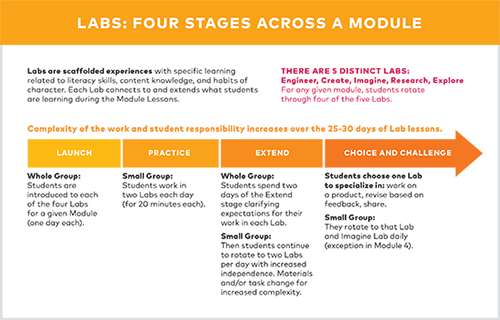About the K-2 Language Arts Curriculum
About K-2 Language Arts Curriculum
Sections on this Page
Overall Structure
The K-2 curriculum offers three hours of rich literacy instruction per day: Two hours of content-based literacyOverall Structure of Module Lessons

Across K-5, students experience four modules over the course of a school year. In K-2, Module 1 is a bit shorter (six weeks rather than eight), so teachers have time to do the other important work of getting classroom routines and culture in place, which often takes more time and deliberate attention for primary-aged students. (Note: For more, see the “Fostering Character in a Collaborative Classroom” section of the Module 1 Appendix.) Each module has a consistent structure of three units, each of which includes one formal assessment.

The curriculum was built using the principles of backward design, meaning that we started by identifying what we wanted students to know and be able to do at the end of each module, and then we built each unit to intentionally get them there. Let’s explore what that means in the first grade classroom introduced in the Snapshot at the beginning of this chapter.
What students learn in Units 1 and 2 helps them prepare for this performance task. (This is the principle of “backward design” in action.)
This unfolding of the three units means that by Unit 3, when the performance task is introduced students are fully equipped to create their “magnificent things” and to synthesize their understanding of what they accomplished through supported, standards-based writing.
K-2 Labs

Labs are an important feature of the K-2 curriculum because they support and extend student learning from the module lessons. They are designed to help teachers ensure that all of their students get the time to play and explore, become immersed in oral language and content knowledge, and practice skills and habits of character that they need—both to live joyfully and to be fully successful and proficient.
The K-2 Labs are one hour long and are complementary to module lessons. These two hours of content-based literacy instruction work together to accelerate the achievement of all students.

The K-2 Labs are designed for six weeks of instruction within an eight- to nine-week module. This design allows teachers to use their discretion to flexibly schedule the Labs to best meet the needs of their students. Teachers may choose to spend that hour during those additional two to three weeks on such things as solidifying structures and routines, providing additional “spill-over” time to support module lessons, providing additional instructional time for ELLs, or for additional explicit language instruction.